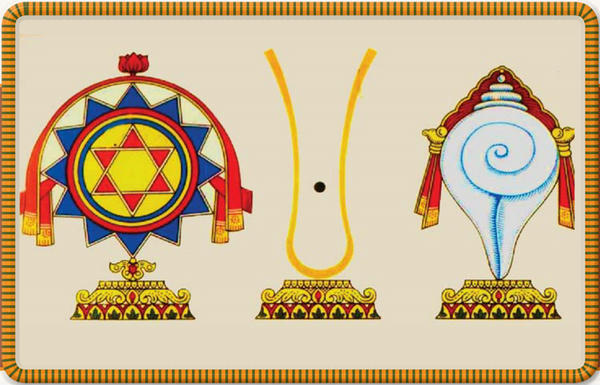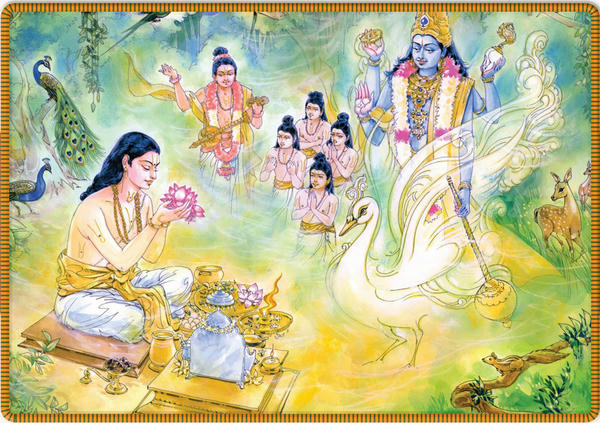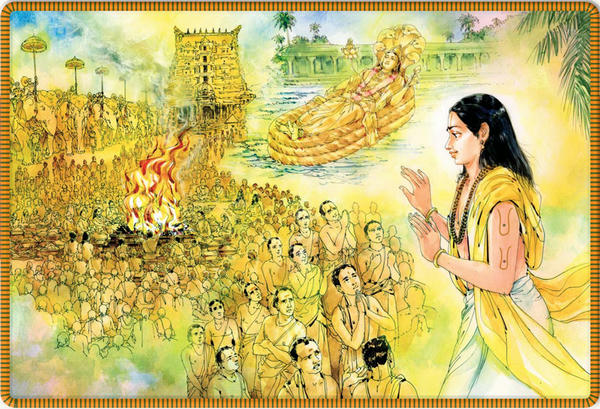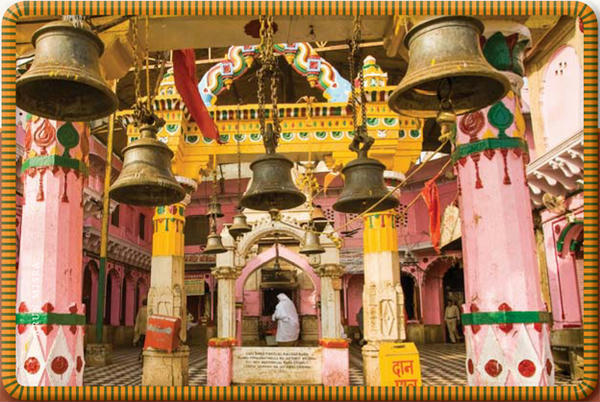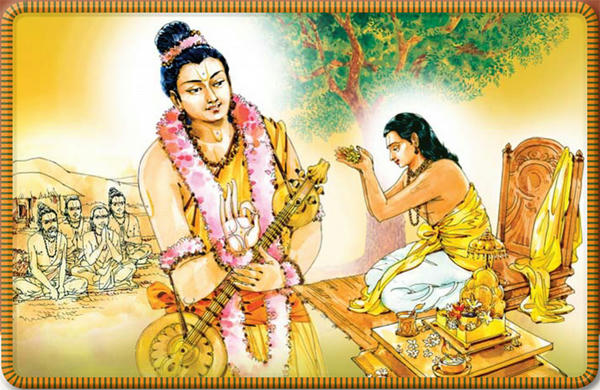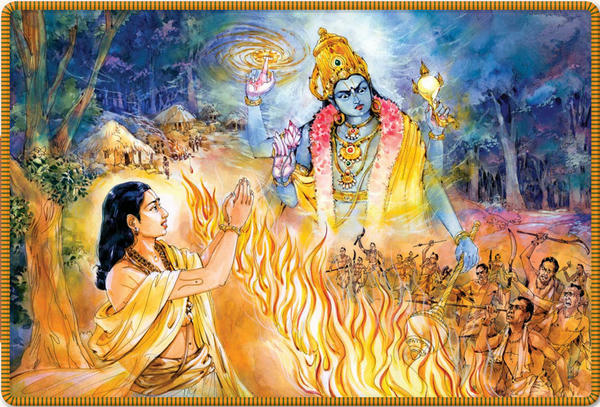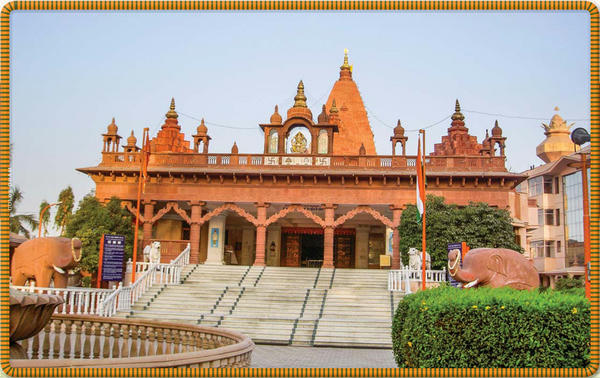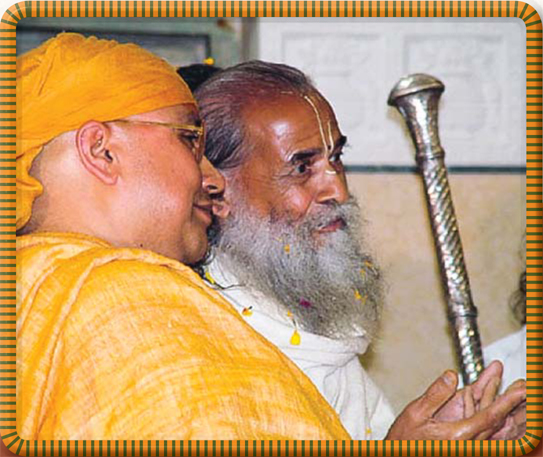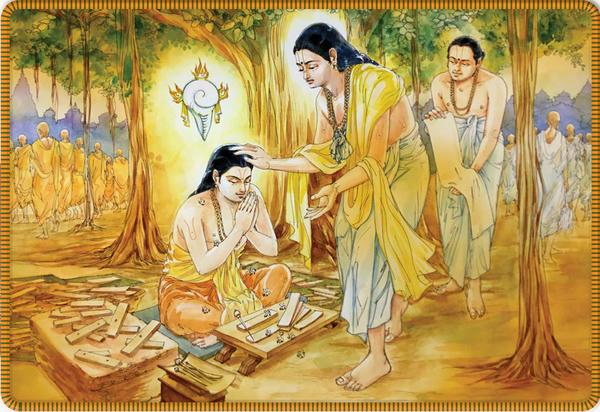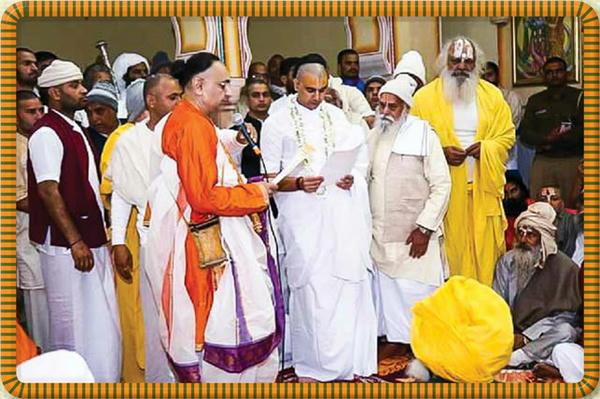Śhrī Nimbārka’s Philosophy
By Brahmachari Vrajvihari Sharan§
If there is any concordance to the apparently cacophonic theologies and philosophies that populate the thickets of contemporary Hindu spirituality, it is due to the efforts of Lord Bādarāyaṇa, author of the Brahmasūtras. In that text of 555 aphorisms, he sought to synthesize a coherent conclusion (anta) to the seemingly self-contradictory totality of divine revelation (Veda: the Saṁhitās, Brāhmaṇas, Āraṇyakas, Upaniṣhads and Sūtras belonging to the various recensions of the four Vedas). The system known as Vedānta (originally a term designating the Upaniṣhads) developed from his aphoristic summary, successfully demonstrated that all of these variegated scriptures are, in fact, harmonious due to their foundation in Brahman.§
However, the secrets of his cryptic teachings remained the preserve of the sincerest seekers and would have remained largely unintelligible were it not for the explanations produced by realized āchāryas after the 5th century ce. Each of the major āchāryas established his line of interpretation as a school, or sampradāya; his particular take on the Brahmasūtras, revealed through divine inspiration. This knowledge was passed down through each school’s sacred guru-disciple lineage (paramparā) which, in genuine cases, originated from the Supreme Being.§
Today, Hindus delving into the limitless treasure-trove of philosophical inquiry become familiar with āchāryas such as Śhrī Śhaṅkarāchārya, Śhrī Rāmānujāchārya, Śhrī Madhvāchārya, Śhrī Viṣhṇuswāmī, etc., each of whom established their own sampradāya of Vedānta interpretation. Among them, Śhrī Śhaṅkarāchārya ranks as pre-eminent due to his numerous erudite treatises in an effort to reclaim the hearts of seekers from the profusion of sects—both theist and atheist—that were popular in eighth-century India. His Kevalādvaita or Advaita Vedānta has been described as a reductionist and idealistic reading of the Brahmasūtras, the Bhagavadgītā and the Upaniṣhads. Commentaries on this scriptural triad, known as the Prasthānatrayī, are the systematizing exegesis upon which a school of Vedānta could be founded. Śhrī Rāmānujāchārya, Śhrī Madhvāchārya and Śhrī Vallabhāchārya responded to this with their own scripturally substantiated viewpoints in which the Supreme Being retained a personable side, (re-)promoting the relationship of devotee with the Lord as the main mokṣha-sādhanā—means to liberation from transmigration.§
Śhrī Śhaṅkarāchārya used many pūrvapakṣhas (prima-facie views), against which he clarified his doctrines and crystallized those of other schools he saw to be deficient. The majority of rival tenets that he countered belonged to Bhedābheda (also known by the synonym Dvaitādvaita), which scholars suggest is the oldest philosophical understanding of Vedānta, a fact to which pre-eighth century Buddhist writings attest. Some of them go as far as to claim that the Brahmasūtras were composed from a Bhedābheda doctrinal foundation. Of the various post-Brahmasūtra Bhedābheda theologians (such as Bhartāprapañcha, Bhāskara, Yādavaprakāśha, etc.), the oldest continuous tradition of this philosophy belongs to the Svābhāvika-Bhedābheda exegetical school founded by Śhrī Nimbārkāchārya Bhagavān, at whom Śhrī Śhaṅkarāchārya aimed most of his polemic (especially in his Bāihadāraṇ-yakopaniṣhadbhāṣhyam).§
Śhrī Nimbārka composed a brief explanation of the Brahmasūtras, styled the Vedāntapārijātasaurabha (the Fragrance of the Heavenly Flower of Vedānta), which he used to reiterate the ancient philosophy of Bhedābheda against newer philosophies being propounded by Dharmakīrti, a seventh century Buddhist monk of the ancient Nālandā University, who vehemently opposed Vedāntic spirituality. Śhrī Śhrīnivāsāchārya, the successor of Śhrī Nimbārkāchārya Bhagavān, wrote in the beginning of his sub-commentary, the Vedāntakaustubha, that he was commanded by his guru to expand upon the Vedāntapārijātasaurabha in order to clarify any remaining doubts of spiritual seekers regarding the Bhedābheda interpretation of the Vedic scriptures.§
Why is Bhedābheda so crucial to Hindu Dharma? All Hindu philosophies accept that the Vedic texts (Saṁhitās, Brāhmaṇas, Āraṇyakas and Upaniṣhads) are divine revelation. The Upaniṣhads present myriad doctrines on a variety of topics; however, they do not give a unified position on the understanding of a few crucial principles, chief of which is the identity and relationship of the three major ontological categories: Brahman (Supreme soul), Jīva (individual soul) and Jagat (creation). Are the Supreme Soul and individual soul one and the same, or are they different? Is the universe an illusion and therefore not really existing, or does it exist but is just temporary? Depending on which part of a certain Upaniṣhad one peruses, divergent answers may be found.§
Śhrī Śhaṅkarāchārya adopted a unique approach to solve this disparity in his theory of Kevalādvaita: he theorized that those Upaniṣhadic statements that support the illusory nature of creation and the oneness of Brahman and individual soul constitute higher knowledge; all other statements of difference are lower knowledge. Śhrī Madhvāchārya inverted this in his formulation of Dvaita, showing statements of difference as the highest wisdom. Śhrī Rāmānuja’s Viśhiṣhṭādvaita subordinated the assertions of difference under the teachings of oneness. Before all of these āchāryas, however, Śhrī Nimbārka simply taught that if the Veda is divine revelation, then none of it is lower knowledge; all of it should be accepted as equally teaching the supreme knowledge. This all-embracing concept of Svābhāvika-Bhedābheda (natural simultaneous difference and oneness) expounded by Śhrī Nimbārka could account for the concurrent existence of both types of statements. This requires an intellectual openness and all-embracing outlook that may not have appealed to all types of spiritual seekers. Hence, the Supreme Lord empowered the later āchāryas mentioned to start their own traditions. Śhrī Nimbārka’s philosophy also served as foundations for variations by later theologians, such as Śhrī Vallabhāchārya’s Śhuddhādvaita and Śhrī Chaitanya’s Achintya Bhedābheda. Even Śhrī Rāmānuja’s Viśhiṣhṭādvaita is a reformulation of his scriptural teacher Śhrī Yādavaprakāśha’s understanding of Svābhāvika-Bhedābheda.§
So, what does this Svābhāvika-Bhedābheda mean to the spiritual seeker? First and foremost, it allows one to fully embrace the scriptures in their glorious variety. The Supreme Being has created all of us with different mind-sets and proclivities, according to our previous karma, and has established authorized paths that cater to all sorts of viewpoints on returning to the Divine. Secondly, it permits us to understand the variety existent in this creation as expressions of the Divine, and find joy in this vibrancy. Developing an open mind and an accepting heart is the first step on the ladder to spiritual progress required by the Bhedābheda philosophy. Thirdly, it encourages us to experience the world and really understand the temporary nature of the pleasures it has to offer. By doing this, one gains the power to discriminate between those pursuits that will give us temporary happiness and those that will give us eternal happiness.§
MANIAM SELVEN§
Nimbārka Bhagavān is immersed in the worship of the holy murti Śhrī Sarveśhvara Bhagavān, which was given to him by Śhrī Nārada Muni (holding a vina). Nārada had received it from the four sages: Sanaka, Sanandana, Sanātana and Sanatkumāra; and they received it from Nārāyaṇa Himself in the incarnation of Śhrī Haṁsa (the white swan).§
Finally, it helps us to explore myriad ways of interacting with the Divine. If we find peace in the scriptural meditations of oneness with the Divine, then that is perfectly acceptable—similarly true of meditating on having a relationship of any type with the Supreme. Whether we are content with accepting the Supreme Being as the origin or the source of conscious energy, or we prefer to relate with the Supreme as our friend, master, parent, regent or love: all are acceptable. Bhedābheda provides a firm theological grounding, using which seekers can experience a scripturally authorized connection with the Divine in the manner most suited to them. The only proviso is that seekers must be honest with themselves, and develop the maturity needed to embrace variety, eschewing a zealous grip on any philosophy that professes to be the only path.§
The Life of Śhrī Nimbārka Bhagavān
Excerpts from the ancient hagiography Nimbārka Vikrānti, rendered into English by Brahmachari Vrajvihari Sharan, PhD§
The spiritually fertile land of Bhārata, the traditional name for India, has been darkened during numerous oppressive epochs. Just over fifty years before Śhrī Śhaṅkarāchārya Bhagavatpāda incarnated, Hindus who visited places of pilgrimage were taxed, public celebrations of major festivals like Diwali were banned, Deities were forcibly removed from temples, and conversion was made financially attractive by non-Hindu rulers. Still, on the peripheries, devout followers of Hindu Dharma strived to preserve Vedic teachings for future generations, ever wary of the threats of persecution and death. Brāhmaṅas who had benefitted from state sponsorship were now without the support of the kings. Although the majority remained committed to Dharma, even if that meant languishing in poverty, a sizable number took to increasingly superstitious rituals in an attempt to create new sources of funding. Whenever the scriptures were invoked by the wise to make people realize that these fanciful crazes were illogical, the few miscreant Brāhmaṅas sought to discredit, and in some cases harm, those honest teachers who adhered to Dharma.§
In Mathurā, the main city of the Braj region, which the Supreme Lord chose for the beginning of His Earthly pastimes 5,242 years ago, the situation was dire. Mathurā had great strategic significance as a prominent city on trade routes that not only spanned the length and breadth of Bhārata, but also from Rome in the West to China in the East. The wealth of the traders made it an ideal focus for taxation, so conquering Mathurā remained top priority for kings. Non-Hindu rulers built many sprawling religious edifices in an effort to attract Hindus away from the simple ancient temples and hermitages. The few remaining Hindu ascetics avoided the city and continued to meditate in the forest groves around Mathurā, including the holy thickets of Vāindāvana. Unfortunately for them, even their āśhramas were not spared, so the majority of Mathurā’s sādhus adopted a peripatetic lifestyle, continuing their meditations on the Lord in the devotional mood of Vāindāvana. When they were harassed at a certain place, they would simply move on; true sādhus find the Lord wherever they are.§
MANIAM SELVEN§
Śhrī Nimbārka arrives at the famed Anantapadmanābhaswāmī Temple in Kerala for darśhan. As today, one can see the murti of Viṣhṇu reclining on the serpent Śheshanāga in the nearby pond. Brahmins are performing a lavish yajña, more for wealthy patrons than for God. Some of them leave the yajña to welcome the visiting saint, angering the local Brahmins.§
The Sādhus of Braj Meet Śhrī Aruṇa ṣiṣhi§
One such group of sādhus decided to remedy the situation. They had heard of one last āśhrama, that was home to the great descendant of Bhāigu Ṛiṣhi, Śhrī Aruṅa Ṛiṣhi. The great Ṛiṣhi and his wife Jayantī Devī were extremely poor, but that did not deter thousands of earnest students from building huts near their home, forming the famous Aruṅāśhrama. In the autumn, the sādhus set off following the trade route from Mathurā towards the western sea ports, arriving at the major city of Pratiṣhṭhāna (modern Paiṭhaṅ) just before the holy Mārgaśhīrṣha month (November-December) commenced. They learned that the great sage’s hermitage was in the nearby village of Vaidūrya Pattanam (modern Mūṅgī) on the southern bank of the Godāvarī River.§
Upon entering the āśhrama, the sādhus were moved to tears by the nostalgic vision before them, not seen in Braj for many decades: young brahmachārīs were reciting the Veda, wives of resident seers were preparing evening bhoga, and Śhrī Aruṅa Ṛiṣhi was sitting under a nimba (neem) tree, sharing the knowledge of the Chāndogya Upaniṣhad with advanced students.§
Aruṅa Ṛiṣhi received the sādhus with traditional Vedic hospitality, and was utterly dismayed to hear that Braj, particularly Mathurā and Vāindāvana, was no longer safe for devotees of the Lord. As a solution, he encouraged them to perform a Gopālayajña (a fire-ritual to the Supreme Lord in His form as Śhrī Gopāla) in the safety of his āśhrama, with full faith in the Lord’s promise to incarnate whenever there was a decline in Dharma (Bhagavadgītā 4.7-8). They were to perform this month-long yajña during the holy month of Mārgaśhīrṣha, which is dear to the Lord (Bhagavadgītā 10.35).§
At the completion of the observance, thankful for this opportunity, the sādhus wished to show their gratitude to Aruṅa Ṛiṣhi by blessing him. Noting that the couple had no children, they blessed the seer and his wife, saying that by the grace of this Gopālayajña, the Lord would surely respond to the couple’s desire for progeny, while also bringing Dharma back to Braj.§
The Supreme Being and the Love of Devotees§
At the core of the inner realms of existence lies the Eternal Source from which all of creation—with its myriad universes, dimensions, beings, matter and antimatter—arose. The Purāṅas teach of a hierarchy of realms presided over by various emanations of the Supreme Being: Indraloka is the kingdom of Indra, Pitāiloka is where the ancestors reside, Brahmaloka is the realm of Lord Brahmā, Śhivaloka is Lord Śhiva’s domain and Vaikuṅṭha is Lord Nārāyaṅa’s abode. These realms and beings exist during the time of creation. However, at the very beginning, everything was in an unmanifest state of pure brilliance, eternality, consciousness and bliss. It is into this brilliance that everything will be absorbed at the end of time; this brilliance, Parabrahman, is the source of everything.§
According to Vaiṣhṅava teachings from the Ṛigveda, Mahānārayaṅa Upaniṣhad and the Bhagavadgītā, the eternal form of Parabrahman is Lord Śhrī Hari. At the commencement of creation, Lord Hari manifests the Chaturvyūha emanations (Vāsudeva, Saṅkarṣhaṅa, Pradyumna and Aniruddha), then Brahmā, Viṣhṅu/Nārāyaṅa and Śhiva (presiding over each of the three guṅas), and indeed all other Deities, emanations, incarnations and empowered beings. Of all the various forms, in the capacity of preserver, Śhrī Hari is meditated upon as Lord Nārāyaṅa.§
In the realm of Vaikuṅṭha, Lord Nārāyaṅa listened to the entreaties of the sādhus led by Aruṅa Ṛiṣhi. The All-Knowing Lord turned to His most devoted personal associate, the Sudarśhana Chakra—the personality of the divine discus who cuts away pains, suffering and ignorance from devotees in order that they may attain the Supreme. In his essential form, Śhrī Sudarśhana is an emanation of the power of Lord Aniruddha, one of the Chaturvyūha.§
In the Bhaviṣhya Purāṅa, Sūta jī relates the following: “Listen to the activities of the divine soul Nimbārka. He was told by the Supreme Lord: ‘O mighty Sudarśhana, whose brilliance is equal to that of millions of suns! Do this task by My command: reveal the divine path to those who are blinded by the darkness of ignorance” (Pratisargaparvan 7.68-69).§
The Lord told Śhrī Sudarśhana to incarnate in the Tailāṅga region south of the Narmadā River, in Aruṅa Ṛiṣhi’s āśhrama on the southern bank of the Godāvarī River. He would eventually meet Śhrī Nārada Muni who would instruct him on the most confidential secrets of the scriptures. With that knowledge, he would have a vision of the Supreme Lord in the Original, Eternal State. Thus empowered, he was to reinvigorate Dharma: “You must restore Dharma in My lands, in Mathurā, Naimiṣhāraṅya, Dvārakā, Badarikāśhrama, Sudarśhanāśhrama and the many others, O spotless one!’ Saying ‘Aum,’ Lord Śhrī Sudarśhana accepted the Lord’s command, and the fulfiller of the desires of the Lord’s devotees manifested himself on the Earth” (Pratisargaparvan 7.71-73).§
The Incarnation of Śhrī Sudarśhana Chakra§
Back on Earth, auspicious signs were seen in the holy fires during pūrṇāhuti, signalling both the successful completion of the Gopālayajña and the fruition of the blessings the sādhus had given the āiṣhi and his wife. The Braj sādhus began their journey back to Mathurā certain that their wishes would soon be fulfilled.§
On a cool winter evening in the month of Pauṣha, after the departure of the sādhus, Aruṅa Ṛiṣhi had a vision of pure brilliance before him. That brilliance suddenly disappeared into the heart of Aruṅa Ṛiṣhi who relished the divine encounter—not quite certain what happened, but thrilled nonetheless. When Jayantī Devī came to take the blessings of her husband after her evening worship, he placed his hand on her head and that luminous energy transferred from his heart to her mind. As time went on, Aruṅa Ṛiṣhi was overjoyed to see the signs of pregnancy in his wife, knowing that the blessings of the sādhus of Braj had borne fruit.§
In the calm, cool air of the full-moon of Kārttika, the moon was situated in the Kāttikā (Pleiades) constellation of the Vāiṣhabha (Taurus) sign, with Meṣha (Aries) as the ascendant, and with Chandra (the moon), Maṅgala (Mars), Budha (Mercury), Bāihaspati (Jupiter) and Śhani (Saturn) in exaltation. This extremely auspicious cosmic arrangement heralded the arrival of a divine incarnation. The attacks on sādhus and hermitages unexpectedly calmed down, and the fires of the evening agnihotra grew bright; flowers were in bloom, animals rested gladly, and humanity was peaceful. The Gods rejoiced in the heavens, the ancestors were filled with delight, for at the exact moment of sandhyā, evening twilight, the glorious brilliance of Lord Sudarśhana was born from the womb of Jayantī Devī.§
Śhrī Nimbārka’s Early Life§
During his Nāmakaraṅa ceremony, the divine baby, who was showing signs of advanced cognition, was given the name Niyamānanda. Other names bestowed on him were Āruṅi (the son of Aruṅa Ṛiṣhi), Jayanteya (the son of Jayantī) and Haripriya (dear to Hari). When the boy was five years old, Aruṅa Ṛiṣhi noticed, to his great delight, that instead of playing with the local children Niyamānanda would sit for hours on end, absorbing the Vedas as they were being taught to the students. As her son’s eighth birthday approached, Jayantī Devī organized his upanayana saṁskāra. Amidst the Vedic rites, Aruṅa Ṛiṣhi invested his son with the yajñopavīta, the sacred thread worn over the left shoulder, and initiated him into the holy Gāyatrī Mantra. Soon after, the vedārambha was performed and the youth’s formal religious studies commenced. Within a short time, Niyamānanda mastered the extensive scriptural body of knowledge that is the Vedic canon: the four Vedic Saṁhitās, Brāhmaṇas, Āraṇyakas and Upaniṣhads, as well as the Sūtras and Smāitis.§
MANIAM SELVEN§
This art depicts the famed initiation moment, when Śhrī Nārada Muni blessed Śhrī Nimbārka Bhagavān (seated). He is also given the Śhrī Sarveśhvara Deity, which glows effulgently on the right. On the left we see Śhrī Nimbārka’s four main disciples: three renunciates and one a householder.§
Relocating to the Spiritual Lands§
Niyamānanda was enthralled by his father’s recounting of the various incarnations of Śhrī Hari and was particularly taken by the accounts of Bhagavān Śhrī Kāiṣhṅa’s activities. Another band of sādhus traveling from Braj visited the āśhrama, enkindling Niyamānanda’s desire to live in Braj. Aruṅa Ṛiṣhi and Jayantī Devī, fully aware that theirs was no ordinary boy, consented to his wish. Accompanied by a few renounced souls, Aruṅa Ṛiṣhi, Jayantī Devī and young Niyamānanda began the journey to Braj, stopping at various holy places enroute. Finally, they arrived at Braj, where they visited Śhrī Kāiṣhṅa’s place of incarnation in Mathurā. Upset that the land was overrun by people with no faith in Śhrī Kāiṣhṅa, they retired to the nearby forests and groves. In a grove midway between Barsānā, the land of the incarnation of Śhrī Rādhā Devī, and Govardhana, where Śhrī Kāiṣhṅa took His cows to graze, Niyamānanda asked his parents to establish their new dwelling. Later that place would become renowned as Nimbagrāma, or Neemgaon, the holy ground where Niyamānanda performed his austerities.§
Śhrī Sudarśhana Is Given the Name Nimbārka§
Lord Brahmā, architect of creation, presiding Deity of rajoguṅa and grandfather of all living beings, is an expansion and devotee of the Supreme Lord, eternally engaged in meditation upon Him. He noticed that Lord Nārāyaṅa’s right hand was empty: the Sudarśhana Chakra had disappeared. Whilst eight human years had elapsed on Earth since Niyamānanda’s incarnation, a miniscule amount of time had passed for Lord Brahmā—His twelve hours (one kalpa) is equivalent to 1,000 mahāyugas (4.32 billion human years). Knowing that Brahmā Jī desired to see Sudarśhana, Lord Nārāyaṅa dispatched Brahmā Jī to signal Niyamānanda to start his mission. Lord Brahmā decided he would take on the form of a Buddhist monk, generally mistrusted by Hindus in that era, to test Niyamānanda.§
In the late afternoon, Aruṅa Ṛiṣhi had gone to the banks of the Yamunā River for evening worship, and Jayantī Devī was busy gathering flowers. Little Niyamānanda was playing with the other youngsters when a Buddhist monk arrived at the āśhrama. The monk explained that he was meditating in the nearby forest but, as he was a Buddhist monk and new to the area, his attempts to beg alms from many houses were met with refusal. Out of desperation, he had come to this hermitage. Distraught at the monk’s plight, Niyamānanda asked him to rest and said food would be arranged. The monk was sad, however. He explained that it was past sunset and he now must fast, as his rules permitted him to eat only during the hours of sunlight.§
Niyamānanda consoled the monk, saying it only appeared that the sun had set due to the thick jungle surrounding the āśhrama. He pointed to a group of neem (nimba or Azadirachta indica) trees and said, “Look! The sun is just behind these trees. Please take your meal.” Delighted to see the sunlight, the monk relished the meal offered to him. As he finished the last morsel, the sun abruptly disappeared. A nearby water clock revealed that, in fact, it was 96 minutes (ghaṭi-chatuṣhṭayam) into nighttime. Seeing the spiritual prowess of Niyamānanda, the monk revealed his true form of Lord Brahmā. Niyamānanda immediately prostrated and begged forgiveness; as the sun amidst the Neem trees was actually his own effulgence which he had, in compassion for the monk’s hunger, projected to look like the sun.§
Lord Brahmā spoke in a soothing tone to Niyamānanda, reiterating the command of the Supreme Lord: “O mighty Sudarśhana, whose brilliance is equal to that of millions of suns, reveal the divine path to those who are blinded by the darkness of ignorance. You must now accomplish the goal for which you have incarnated. Soon after I leave, my son Nārada Muni will come [and explain more]. And, because you have shown me the sun (arka) amidst the neem (nimba) trees, you will henceforth be known by the name Nimbārka by people and especially in the scriptures” (Āchāryacharitam, Ādyāchāryacharitra, 3.37-39).§
Lord Brahmā then told Nimbārka of his previous birth as the great Havirddhāna Muni, who appeared to solve the confusions of the great convention of sages and seers held in Naimiṣhāraṅya during Dvāpara Yuga under the auspices of Śhaunaka Ṛiṣhi. Lord Brahmā continued, saying that, through Śhrī Nārada Muni, Nimbārka would realize all his former incarnations and, indeed, his eternal position. Nimbārka, overjoyed at the darśhana of Lord Brahmā, bowed again and again to the grand-architect of the universe. Smiling, Lord Brahmā disappeared.§
MANIAM SELVEN§
Nimbārka Bhagavān was attacked by jealous Brahmins at night in his forest camp. After failing to kill him with their weapons, they set fire to his dwellings. Śhrī Padmanābhaswāmī arrives, intent on dispatching the mob, but Nimbārka Bhagavān, using the fire as a protective wall, beseeches the Lord to forgive them.§
The Glory of the Dīkṣhā Guru: Back to the Beginning§
Following this encounter with Lord Brahmā, Nimbārka found himself pondering the great questions of life. Realizing that the glorious scriptures sometimes had divergent views, he asked his father to instruct him in a coherent conclusion that made sense of these differences. Aruṅa Ṛiṣhi knew that long ago there existed a system of Vedānta, based on the writings of Bhagavān Bādarāyaṅa, that provided sound answers to these questions. However, the teachers of the Vedānta traditions had suffered centuries of persecution and Vedānta had no true representative on the Earth when Aruṅa Ṛiṣhi himself was a student. Understanding his inability, he meditated on the Supreme Lord, seeking a solution.§
Listening to the prayers of Aruṅa Ṛiṣhi, the Lord turned to His devotee Nārada Muni, the mind-born son of Lord Brahmā, and indicated that now it was time for him to bequeath the knowledge that had been imparted to him by his elder brothers, the quadruplets Sanaka, Sanandana, Sanātana and Sanatkumāra. These four sages were the disciples of the Śhrī Haṁsa [swan] incarnation of Śhrī Hari. The Vedānta, the confidential mūlamantra and advanced theology, and the worship of the eternal Deity form of the Śhrī Sarveśhvara Śhālagrāma, all given originally by the Supreme to the four sages, were now to find their first ever human recipient in Śhrī Nimbārka Bhagavān.§
Nārada Muni gladly bowed to Śhrī Hari and descended to Earth, thrilled to be returning to the holy land of Braj. When Aruṅa Ṛiṣhi and Śhrī Nimbārka saw Śhrī Nārada Muni, they fell flat on the ground, prostrating to this divine visitor. Śhrī Nārada Muni explained that he had come to instruct Śhrī Nimbārka on the highest truth: “Nimbārka! You are the incarnation of Śhrī Sudarśhana, who always obeys the command of the Supreme Lord Śhrī Kāiṣhṅa. Therefore, I will perform the initiation ceremony for which you are now eligible” (Āchāryacharitam, Ādyāchāryacharitra, 4.8-9).§
Śhrī Nārada Muni initiated Śhrī Nimbārka with the pañcha-saṁskāra-vaiṣhṅava-dīkṣhā and instructed him in the science of spirituality. He taught him the rituals of Pañcharātra Āgama and also the highest knowledge of Svābhāvika-Bhedābheda Vedānta, which remains the most coherent philosophical understanding of the scriptures. Finally, he bestowed upon Śhrī Nimbārka the Śhrī Sarveśhvara Śhālagrāma. With the parting instruction to re-establish Dharma across the land, Śhrī Nārada Muni returned to the Lord’s abode.§
Taking up the Mission§
Resolved to have darśhana of the Lord’s original eternal form, in accordance with the teachings of his guru, Śhrī Nimbārka began to perform austerities. He renounced the world, following the rules of naiṣhṭhika brahmachārya (perpetual, total mental and physical celibacy), becoming a sannyāsī known as Śhrī Nimbārka Muni. He immersed himself in japa of the mantras given at initiation, and in meditation on the Supreme. He ate no solid food, drinking only the extremely bitter juice of pressed neem leaves to sustain his body.§
Day by day his spiritual glow grew, until finally he attained the vision of the Supreme Lord, Śhrī Hari, in the eternal, original, most secret form found in the essence of the scriptures—the form of Śhrī Rādhā-Kāiṣhṅa unified. He became aware of all his past existences and those he would take in the future; he realized that his eternal position was that of Sakhī Raṅgadevī, the closest associate of the Supreme Being. As such, he was the combined incarnation of both Śhrī Kāiṣhṅa’s emanation as Lord Aniruddha through Sudarśhana, and Śhrī Rādhā’s emanation as Raṅgadevī. He remembered the command of the Lord that brought him to Earth. His parents and all who resided in the āśhrama witnessed this process, realizing that, indeed, Śhrī Nimbārka was a divine incarnation. They henceforth referred to him as Śhrī Nimbārka Bhagavān and learned from him the truth of all existence. His parents happily remained in the āśhrama while the renounced Śhrī Nimbārka began his work.§
Purifying Footprints: the Spiritual Revival of Bhārata§
Accompanied by a few disciples, Śhrī Nimbārka set out on foot across the country, overnighting in the forests on the edge of villages and towns enroute. He departed in the springtime towards the north, passing Indraprastha before having darśhana at Haridwar, Rishikesh, Gaṅgotri, Yamunotri and finally at Śhrī Badrinātha. He then trekked to Śhrī Muktinātha and Dāmodarakuṅḍa high in the Himalayas. Having paid obeisance to the natural origin of all Śhālagrāmas at Dāmodarakuṅḍa and worshiped Śhrī Sarveśhvara Bhagavān with the holy waters of the lake, he turned southeast, aiming for Purī. As he was descending through the Himalayan foothills in what is now Assam, his disciples made camp on the banks of the vast Brahmaputra River. They rested a few days there, reacclimatizing to the heat of the plains, observing the river in its autumnal spate.§
BRAHMACHARI VRAJVIHARI SHARAN§
Pictured at a flag-hoisting ceremony during the Ujjain Kumbh Mela (left to right): the 48th Jagadguru Nimbārkāchārya Śhrī Śhrījī Mahārāj of blessed memory; Swāmī Govind Dev Giri Jī (founder of the renowned Maharshi Ved Vyas Pratishthan and numerous Vedic colleges); and the newly enthroned 49th Jagadguru Nimbārkāchārya, Śhrī Śhyām Śharaṇ Devāchārya Jī Śhrī Śhrījī Mahārāj.§
One afternoon as Śhrī Nimbārka was walking on the banks of the river, he heard the desperate cries for help of nearly 100 people on a large merchant vessel that was sinking in the middle of the raging waters. As he watched, the boat sank and the people were adrift in the dangerous rapids. Helplessly looking on, one disciple noticed that Śhrī Nimbārka was nowhere to be seen. The next second, cries of relief and amazement filled the air as the boat magically reemerged. Śhrī Nimbārka was seated in the middle of the now buoyant vessel. He helped all those who were swept away back onto the boat and guided it safely to shore. The grateful survivors sought to reward Śhrī Nimbārka with great sums of money, but the renounced āchārya asked them instead to use the wealth to help the poor and destitute in the area. They all became his disciples. It is thought that some of them are ancestors of Śhrīmanta Śhaṅkaradeva, the founder of the later Mahāpuruxīya Dharma in the 15th century, of which the Sattra monasteries of Mājulī Island (the world’s largest river island) are renowned.§
Continuing south, Śhrī Nimbārka arrived in Purī, where he had darśhana of Lord Śhrī Jagannātha, Śhrī Balabhadra and Śhrī Subhadrā Devī at Their abode, and then pressed on. He saw that not only were there various atheist philosophies that were extremely popular, but many who professed to be followers of the eternal Dharma were, in fact, either so confused as to have a highly superstitious view of reality, or were scofflaws, scrounging money from any source they could. The holy places had fallen into disrepair, and temples were overrun by profiteers seeking to usurp Deity offerings to fuel their vices.§
However, when Śhrī Nimbārka set foot on these sites, people left what they were doing to come and see this muni who was aglow with spiritual potency. They felt their sorrows and troubles melt away, and experienced bliss through his every comforting word, replete with the essence of the scriptures. Thousands abandoned immoral practices and returned to the shelter of Vedic Dharma. He was invited to debates with top scholars in each region, and, through the knowledge imparted to him by Śhrī Nārada Muni, he reasserted the supremacy of the Vedic path. A few scholars even renounced the world, becoming sannyāsīs of Śhrī Nimbārka’s holy order of monks. Slowly but surely, the number of renunciates grew, and after a short time, the traveling party consisted of thousands of sannyāsīs. In his heart, however, Śhrī Nimbārka was in constant meditation on Parabrahman, Bhagavān Śhrī Rādhā-Kāiṣhṅa.§
Śhrī Nimbārka Meets Śhrī Agastya ṣiṣhi§
Śhrī Nimbārka and his disciples journeyed further south, passing through the Pothigai hills (Agastiyar Malai). One morning, as Śhrī Nimbārka went in search of a stream to bathe in, he had a divine vision: the ancient sage Agastya Ṛiṣhi sitting on the bank of the Rāmagaṅgā (Ramanathi), a tributary of the Tāmraparṅī (Thamirabarani) River. However, the sage was dejected. Seeing Śhrī Nimbārka Bhagavān, he prostrated and explained that long ago the river flooded and washed away his āśhrama and students. Agastya Ṛiṣhi knew that all those who died had ascended to elevated states of existence; but a few surviving āiṣhis had cursed the river, saying that because she had committed brahmahatyā (murder of priests), she was tainted with their blood and should become a river of blood. Agastya was sorrowful that even after thousands of years, the river, source of biodiversity and economy from there to the tip of South India, was still dead, resulting in poverty and illness for the whole area.§
Telling the sage not to worry, Śhrī Nimbārka walked down to the river of blood, and touched the toe of his right foot to the water. Instantly the river began to flow clear. Fish soon returned to the waters and the surrounding land once again became verdant. Happiness returned to the kingdoms, and Agastya Ṛiṣhi was overjoyed. Realizing that Śhrī Nimbārka was a divine being, he asked the monk to reveal his hidden form. The compassionate incarnation revealed himself as Sudarśhana Chakra, and then revealed the origin of the Sudarśhana Chakra, Lord Aniruddha, whose four hands wielded the conch, mace, lotus and gesture of benediction. Ecstatic, Agastya Ṛiṣhi requested the great āchārya to reveal the purpose of his incarnation, and they spent the rest of the day glorifying the Lord. The vision of Agastya Ṛiṣhi then disappeared, and Śhrī Nimbārka returned to his disciples.§
Śhrī Anantapadmanābhaswāmī, the Savior’s Savior§
Tamil literature of the ancient Sangam period glorifies the Lord in His form of Śhrī Anantapadmanābhaswāmī, Lord Padmanābha (Lord Nārāyaṅa with a lotus in His navel upon which Brahmā appeared), who is reclined upon the Ananta Śheṣha (divine serpent) bed. Śhrī Nimbārka was told by his Malayali disciples that greedy Brāhmaṅas had overthrown the pious attendants of Śhrī Anantapadmanābhaswāmī and were promoting an illogical, superstitious concoction as Vedic Dharma. Many people left the Dharma because of this, and thousands took up atheistic philosophies. Saddened, Śhrī Nimbārka turned southwest and headed for what is now Thiruvananthapuram, the city of Śhrī Anantapadmanābhaswāmī and current capital of Kerala.§
When he and his troupe of ascetics made their way through town to Śhrī Anantapadmanābhaswāmī’s temple, people stopped what they were doing and marveled at the sight. A few non-Vedic rituals being organized by nefarious Brāhmaṅas were going on at the time. Innocent-hearted attendees stood up and welcomed Śhrī Nimbārka, which angered the money-minded Brāhmaṅas. Śhrī Nimbārka was not perturbed. Instead, he magnanimously went to meet them and solicited their blessings. With fake smiles, as the whole city looked on, the duplicitous Brāhmaṅas gave Śhrī Nimbārka a token welcome, and the āchārya moved on towards the temple. The rogues, seething with rage, met in secret to plot the death of this intruder who threatened to destabilize their entrenched ritual scam.§
After enjoying darśhana of Lord Anantapadmanābhaswāmī, together with Śhrīdevī and Bhūdevī, the āchārya and his disciples retired to the forest, set up their encampment and began the evening’s worship. A little while later, a gang headed by the villainous Brāhmaṅas surrounded Śhrī Nimbārka as he sat outside his hut enjoying the blissful sounds of kīrtana from the disciples’ camp not far away. The miscreants hurled abuse. With no reaction from the great āchārya, they charged forward with weapons raised, intending to murder the saint. At that moment, a fruit from the Udumbara tree (Ficus racemosa) above Nimbārka Bhagavān’s hut fell in front of him, rolled to his feet and touched his right toe. A blinding light emerged from the red, fig-like fruit, stopping the would-be murderers in their tracks. From that light emerged a muni, who praised Śhrī Nimbārka for turning the mere fruit into a holy being, replete with form and knowledge similar to Śhrī Nimbārka himself. Nimbārka Bhagavān named him Audumbarāchārya (the teacher who appeared from an Udumbara fruit). Normal people would have seen this and recognized the divine power before them. Not this bunch.§
Instead, they regrouped, realizing that it would be challenging to defeat the āchārya, who to them seemed a powerful magician. They set the āchārya’s hut alight, encircling him with fire. Śhrī Nimbārka disappeared into the flames, and the marauders began to celebrate. Śhrī Nimbārka was more than capable of quelling the fire, but the Supreme Lord wished to perform a pastime for the sake of inspiring His devotees to return to pure, scripturally guided devotion.§
Śhrī Padmanābhaswāmī, observing the unfolding spectacle in the forests near His temple, became agitated that these people would cross the line from lying to murder just to protect their ritual scam business. His ire appeared as Lord Narasiṁha, who swallowed the flames surrounding Śhrī Nimbārka and sent them toward the gang. The Brāhmaṅas began to quake in their boots. Knowing that their sins were unforgivable, their last hope was to seek the grace of the divine āchārya, and they begged him piteously.§
MANIAM SELVEN§
In a forest near Dwārkā, a group of extremists attend a Jain festival, having chased all believers of the Veda out of the area. Angered that a Vedic āchārya dares to visit, they seek to slay him. Lord Dvārakādhīśh intervenes. Due to His blessings, when Śhrī Nimbārka’s right toe touches the earth, a torrent of water is released that keeps them at bay. Astonished by the miracle, the attackers repent and seek the shelter of Lord Dvārakādhīśh.§
Śhrī Nimbārka sought the blessings of Lord Anantapadmanābhaswāmī to proceed, and with a divine side glance from the Lord signaling His assent, Śhrī Nimbārka gazed at the fire surrounding everyone and the flames were miraculously extinguished. Śhrī Padmanābhaswāmī in his Narasiṁha form grew calm, and Śhrī Nimbārka directed the defeated Brāhmaṅas to join his disciples and cook sweet rice to offer to the Deity. They accomplished this through the powers of Śhrī Audumbarāchārya, who accompanied them. When they returned, followed by the entire retinue of disciples, Śhrī Nimbārka led the worship of Śhrī Narasimha and Śhrī Padmanābhaswāmī. As he offered the sweet-rice porridge in dishes made from coconut shells, the disciples and the repentant Brāhmaṅas sang praises. Before returning to the sanctum of the temple, Śhrī Padmanābhaswāmī told the gathering to accept the teachings of Śhrī Nimbārka and Vedic Dharma. Seeing this from His heavenly abode, Lord Śhiva requested Lord Padmanābhaswāmī to reside with Him forever at this miraculous place. Even today one can have the darśhana of the Śhivalinga under the hand of Lord Padmanābhaswāmī reclining on the Śheṣha bed, with Śhrīdevī and Bhūdevī nearby, and Śhrī Narasimha Bhagavān’s temple in the vicinity.§
The Liberation of Śhrī Dvārakā Purī§
Śhrī Nimbārka continued his journey, heading up the coast to Śhrī Dvārakā Purī, the ancient kingdom of Bhagavān Śhrī Kāiṣhṅa. He was disheartened seeing the city overrun with atheistic people who had no regard for the divine heritage of the area. These citizens hurled verbal and physical abuse upon those who came to Dvārakā with hopes of praying at the site of Śhrī Kāiṣhṅa’s former palace. Śhrī Audumbarāchārya records in the Nimbārkavikrānti that Śhrī Nimbārka was a completely open-minded, compassionate being. He never killed evildoers. Instead, he purified them, removing their bad qualities so their inherent good qualities could shine.§
As Śhrī Nimbārka entered Dvārakā, a festival was being held by atheists to honor the founder of their philosophy. Śhrī Nimbārka sensed that his presence might vex the extremist followers of that cult, so he kept his distance. Seeking water for his disciples, he made his way to a nearby reservoir, where it happened that a few extremists were also fetching water. Seeing that Nimbārka, like his followers, was adorned with yajñopavīta and kaṅṭhī (sacred thread and prayer necklace), which the atheists had eradicated from the region long ago, hatred erupted in their minds. They began verbally assaulting the disciples and their leader.§
Śhrī Nimbārka tried to placate the mob, but they sent for additional sympathisers with as many weapons as they could carry—for on this day they would rid Dvārakā of anyone who believed in Bhagavān Śhrī Kāiṣhṅa, Bhagavān Śhrī Śhiva, Bhagavatī Durgā Devī or any other Vedic tradition. A few moderate citizens tried to pacify the assailants, but that simply precipitated more violence as the extremists began their attack. The moderates ran to Śhrī Nimbārka and begged for protection. His disciples similarly gathered round, seeking shelter from the divine āchārya.§
Digging his right toe into the ground, he flicked up some earth with his toenail, which shone like moonlight. From the tiny hole in the ground sprang a mighty torrent of water, gushing towards the aggressors. A few, in wonder at the supernatural sight, surrendered immediately to Śhrī Nimbārka and begged his forgiveness and were not affected; but those who remained intent on his destruction were washed away by the miraculous river.§
Śhrī Nimbārka suddenly grew in size, becoming as large as a mountain. The flood of water rose up, bringing with it the assailants. As soon as the water touched his feet, it calmed and retreated back into the earth. The bodies of the attackers were washed up, and those still alive by dint of their latent good karmas began to repent. Śhrī Nimbārka returned to normal size and, with a smile, brought the drowned antagonists back to life. Absolutely gobsmacked and thoroughly convinced of the āchārya’s divinity, they begged forgiveness and pleaded to be accepted as disciples. Śhrī Nimbārka’s face was wet with tears, as he was forced to resort to deadly means to free these souls from their vicious ways. He gladly took them under his tutelage and thus reestablished Dharma in Dvārakā. Those who decided to renounce the world were initiated by him with the pañcha-saṁskāra-vaiṣhṅava-dīkṣhā, restoring the practice of tapta-mudrā at Dvārakā. Those who elected to remain as householders were initiated into sādhanā-bhakti (also known as prapatti/śharaṅāgati, the path of surrender to the Supreme Being) and were invited to restart worship of the Lord of Dvārakā, Śhrī Dvārakādhīśha.§
Return to Braj; Anointing a Successor§
Śhrī Nimbārka viewed Śhrī Vāindāvana’s forest as the natural temple of the Lord. When he returned from his travels to live at Nimbagrāma, he and his disciples would visit Śhrī Vāindāvana in the daytime to meditate and perform service for Śhrī Sarveśhvara Bhagavān, but would return to Nimbagrāma in the evening, as it was inconceivable to pollute the holy forest with human bodily functions, or to visit upon it the destruction of nature that accompanies the building of dwellings and infrastructure.§
From time to time, great scholars traveling throughout Bhārata challenging other scholars in debate would visit Nimbagrāma. Often the mere sight of the divine ascetic āchārya would evaporate their ambitions, and they, too, would become his disciples.§
After Śhrī Sudarśhana had left Vaikuṅṭha to begin his mission on Earth, the personification of the divine conch, Śhrī Pāñchajanya, who resides in the left hand of Lord Nārāyaṅa, requested guidance from the Lord. Śhrī Nārāyaṅa said that Śhrī Pāñchajanya should also incarnate, but he would not remember his real identity until he became a disciple of Śhrī Sudarśhana. He accepted this condition and incarnated after a few human decades in the eastern part of Bhārata, becoming a great Śhākta scholar known as Vidyānidhi. He embarked on a tour of India, defeating many prominent scholars in debate. On having darśhana of Śhrī Nimbārka, however, Vidyānidhi realized his true and eternal identity and at once became a disciple, earning the name Śhrī Śhrīnivāsāchārya Bhagavān.§
As the conclusion of his Earthly pastime approached, Śhrī Nimbārka anointed Śhrī Śhrīnivāsāchārya as the next leader of his order of monks. He ordained that although the eternal Dharma had been restarted, it was never to be preached for the sake of increasing the number of disciples. Just as in his own life, where people came to him having observed his virtues, Śhrī Nimbārka Bhagavāṅ admonished his disciples to perfect themselves first—becoming ideal sannyāsīs, self-realized and thoroughly knowledgeable in the scriptures.§
He further taught that the Lord reciprocates with devotees in accordance with their individual proclivities. At the beginning of one’s spiritual journey, a person may seek to acquire divine wisdom. Such a person would contemplate Parabrahman as an abstract, non-anthropomorphic principle, or Avyakta Brahman. When one develops and realizes that surrendering to the will of Brahman is the best path to liberation due to the endless faults of an individual and the inability to know everything, then that person should worship the feet of Parabrahman in the form of Śhrī Lakṣhmī-Nārāyaṅa in accordance with the scriptures.§
As knowledge of the scriptures and devotion to the Supreme Being increased, the disciple could worship the Lord according to a devotional relationship. Meditating upon the Lord from the peaceful state of desirelessness is known as śhānta bhāva. Seeing that the Lord is the creator, the universal sovereign, a person could instead worship the Lord as one’s master, in dāsya bhāva, which is profoundly typified by Śhrī Hanumān Jī’s relationship with Lord Śhrī Rāma. Developing a devotional mood in which the Lord is an eternal friend and companion is known as sakhya bhava; the chief example of this is the relationship between Bhagavān Śhrī Kāiṣhṅa and Arjuna. Where one develops a protective feeling toward a child form of the Supreme, one’s devotion is called vātsalya bhāva, parental affection, like the love of Śhrī Yaśhodā for Śhrī Kāiṣhṅa. Śhrī Nimbārka then said that, whatever the case may be, all four devotional moods should be directed at Śhrī Lakṣhmī-Nārāyaṅa or one of their incarnations.§
However, those who have completely renounced the world and taken sannyāsa dīkṣhā from a true guru ordained in the order of monks founded by Śhrī Nimbārka, who have performed bhajana and meditations on the Supreme Being using the methods described and become perfected therein—those souls would be ready to worship the Supreme Brahman in the form of pure unselfish Love. When devotion to the Supreme Lord in this mood was cultivated, known as the mood of sweetness, or mādhurya bhāva, then the form of the Supreme Being that should be worshiped is no longer Śhrī Lakṣhmī-Nārāyaṅa.§
MANIAM SELVEN§
The great Paṇḍit Vidyānidhi is seated beneath a banyan tree. His guru, Bhagavān Śhrī Nimbārkāchārya, blesses him with Self-Realization, for he is the incarnation of the Pāñchajanya Śhaṅkha, the personified conch shell of Śhrī Kṛiṣhṇa, born to reinvigorate Sanātana Dharma through distilling the authentic essence of the scriptures. A disciple holds a scroll with ten two-line verses written by Paṇḍit, the shortest summary of the Brahmasūtras ever composed, the Vedāntakamadhenu. On the left a group of Buddhist monks walks away. On the right Jain monks retreat. Thus did Śhrī Nimbārka preserve Mathura as a Hindu sanctuary.§
For disciples who have achieved this exalted state of parābhakti, supreme loving devotion, Śhrī Nimbārka revealed for the first time ever that the original, eternal form of Parabrahman—that Supreme Soul, the source of all incarnations and emanations, who is worshiped by all realized and liberated souls in accordance with their own devotional moods—is none other than the unified Bhagavān Śhrī Rādhā-Kāiṣhṅa. Only the most advanced devotees should worship Bhagavān Śhrī Rādhā-Kāiṣhṅa, for only they possess the spiritual wisdom and devotional maturity to correctly envisage the Lord in this original form.§
Spirituality is meant to be a path that caters to every individual’s stage of progression. One cannot simply say that the Lord is ‘X,’ therefore worship ‘X.’ Rather, in this multi-layered revelation, a person can reciprocate with the Supreme Being in accordance with their understanding and feeling until such time as they develop a propensity for parābhakti, whether in this life or in others in the future. This innovation of Śhrī Nimbārka is a legacy which many now ignore, though it has significantly influenced many later denominations and sub-denominations of Vaiṣhṅavism.§
Finally, Śhrī Nimbārka affirmed that the sampradāya’s sole mission is to help people progress spiritually by whatever means are best suited to them. Monks should be supported; but never should a sannyāsī of Śhrī Nimbārka’s holy order seek to build a self-serving institution, accumulate wealth or galvanize followers for the purpose of becoming influential or famous. Instead, each renouncer in Śhrī Nimbārka’s order should strive to remain simple, live a pure and unassuming life and actively eschew the company of persons or events that would result in the popularity of the monk him/herself in place of the popularization of the glorious philosophy of Vedānta. Sannyāsī and householder alike should observe the regulations of the Vaiṣhṅava Dharma, seek to imbibe the philosophy of Svābhāvika-Bhedābheda Vedānta and develop a truly humble nature worthy of a sacred devotional relationship with the Supreme Being.§
Having instructed his disciples and successor, Śhrī Śhrīnivāsāchārya, in this manner in the middle of Nimbagrāma, Śhrī Nimbārka ascended into the sky, where he changed into the form of Śhrī Sudarśhana Chakra and returned to the right hand of Śhrī Nārāyaṅa in Vaikuṅtha. Seeing this glorious event, despite their feeling of separation from this divine incarnation, the devotees present resolved to follow his teachings and help anyone seeking their guidance, without any prejudice based on bodily identifications.§
Even today, living by his example, Nimbārkī monks prefer to worship the Lord in seclusion. They typify the true paramahaṁsa, which is why the tradition is also known as the Paramahaṁsa Sampradāya, the lineage of the supremely renounced.§
ARUN MISRA§
Nimbārka Bhagavān blesses his four main disciples before departing for the eternal realms. He anoints Śhrī Śhrīnivāsāchārya (with conch above his head) as his successor. The other three, Audumbarāchārya, Gauramukhāchārya and Lakṣhmaṇa Bhaṭṭa, pledge to teach all who desire instruction on the path of Vedānta.§
In the centuries following the founder, the tradition suffered greatly. Firstly, extremists and zealots reduced the holy lands of Mathurā and Vāndāvana to blood and bodies, destroying the sampradāya’s libraries, thus severely obstructing the transmission of knowledge in the tradition. Secondly, other Hindu denominations, seeking to gain followers, discredited the Nimbārka Sampradāya in their written histories, or omitted the tradition from their records in order to lay claim to the innovations of Śhrī Nimbārka and his followers.§
Nevertheless, the timeless message of the remarkable ārchārya’s life and teachings continue to be sung not only in Vāindāvana and the rest of Uttar Pradesh, but in Rājasthān, Gujarat, Maharashtra, Haryana, Bengal, Orissa and other states in India and Nepal, as well as in the worldwide Indian diaspora where sincere devotees preserve the message of the founder from millennia ago: that spirituality must be based on the revealed scriptures to have real substance and efficacy; and, even more importantly, that there is nothing in the whole of creation or beyond it that can surpass true and unselfish love.§
ABOUT THE AUTHOR
 Dr. Vrajvihari Sharan Brahmachari is Director of Hindu Life at Georgetown University and an Advisor of the Hindu Forum of Europe; he is also a former lecturer in Asian Religions at Cardiff University, and Senior Teaching Fellow in Sanskrit at SOAS, University of London. vrajvihari@hotmail.com§
Dr. Vrajvihari Sharan Brahmachari is Director of Hindu Life at Georgetown University and an Advisor of the Hindu Forum of Europe; he is also a former lecturer in Asian Religions at Cardiff University, and Senior Teaching Fellow in Sanskrit at SOAS, University of London. vrajvihari@hotmail.com§
ABOUT THE ARTIST
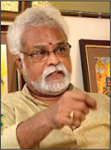 Artist Maniam Selven, of Chennai, enjoys a full range of techniques, from traditional to high-tech. He has done illustrations, signed MaSe, for The Handbook of Tamil Culture and Heritage (depicting the ancient Tirukural), and the Upanishads for the Ramakrishna Mission. maniamselven@gmail.com§
Artist Maniam Selven, of Chennai, enjoys a full range of techniques, from traditional to high-tech. He has done illustrations, signed MaSe, for The Handbook of Tamil Culture and Heritage (depicting the ancient Tirukural), and the Upanishads for the Ramakrishna Mission. maniamselven@gmail.com§
The Nimbarka Movement Today
Many Indologists have underlined the fact that history has not been kind to the Nimbārka Sampradāya. Nevertheless, the tradition has contributed great luminaries to the heritage of Bhārata. Śhrī Jayadeva Kavi (author of the famous Śhrī Gīta Govinda), members of the royal dynasties of Amer, Jaipur, Jodhpur, Merta, Udaipur, Bikaner, Kishangarh, Rupangarh, Bharatpur, Budhiya (Haryana) and others from the 16th century until Indian independence, the great Hindi poets Ghanānanda, Sundar Kuṃvarī, Bāṅkāvatī, Nāgarī Dās, etc., were all followers of monks of the Nimbārka Sampradāya. Nāgarī Dās, the spiritual name of Maharāja Sāvant Singh (born 1699), was the founding patron of the Kishangarh style of painting. Many hundreds of poems he composed after renouncing, dedicated to the Supreme Lord, are sung not only by Nimbārkīs, but also by followers of the PuŚhṭimārga (Śhrī Vallabhāchārya’s sampradāya). These are a small sample of those who credit their talents to the blessings of the Supreme Lord and the gurus of the Nimbārka Sampradāya.§
After Śhrī Nimbārka Bhagavān and Śhrī Śhrīnivāsāchārya Bhagavān, the tradition was led by renounced scholar-ascetics who contributed much to the traditional literature. Śhrī Devāchārya, a 13th-century leader of the tradition, had a branch of disciples within which the famous Dhruvapada (Dhrupada) and Samāj Gāyan reviver Swāmī Śhrī Haridās was initiated in the 16th century. Swāmī Haridās Jī’s devotion caused the appearance of the renowned Deity of Śhrī Bāṅke Bihārī Jī in Vāindāvana, and his disciples maintain a completely ascetic lifestyle. Śhrī Keśhava Kāśhmīri Bhaṭṭāchārya (c.1420-1490) reinvigorated VaiŚṇavism in Braj through his mastery of scholarship and spirituality. His disciple Śhrī Śhrībhaṭṭa Devāchārya (c.1440-1520) was the first-ever author to compose Vāṇī poetry in Braj BhāŚhā, and was an inspiration to other nascent VaiŚhṇava traditions in Braj at that time. His disciple, Śhrī Harivyāsa Devāchārya (c.1470-1540), was a great reformer who charged his 12 main disciples with spreading the tradition throughout Bhārata. Śhrī Paraśhurāma Devāchārya (1525-1607) was anointed as the next leader of the sampradāya out of those 12. He performed austerities in Rajasthan near Lake Pushkar, worked tirelessly to eradicate fanaticism and promoted interreligious dialogue in the late 16th century, being in close proximity to the tomb of the Sufi saint Moinuddin Chishti. Successors of Paraśhurāma’s lineage are the Jagadgurus of the entire Nimbārka Sampradāya.§
Paraśhurāma’s elder god-brother, Śhrī Svabhūrāma Devāchārya, similarly worked to eradicate fanaticism and protected Hindus, establishing 52 centres in Punjab, Haryana, Rajasthan and Mathura. A sizeable number of modern Nimbārkīs are part of his branch. Another famous monk among the 12 disciples was Śhrī Uddhavaghamaṇḍa Devāchārya, who initiated the Rāsa Līlā performances of the pastimes of Śhrī Rādhā-KāiŚhṇa. Śhrī Mukundaśharaṇa Devāchārya was dispatched towards Mithilā, and there are still many followers in this sub-lineage.§
Today, followers of the Nimbārka Sampradāya are found throughout India, Nepal, Bangladesh and the diasporas. Hundreds of temples, monasteries, schools, orphanages, hospitals, clinics and libraries are maintained by Nimbārkīs. The 48th Jagadguru Nimbārkāchārya, Swāmī Śhrī Rādhāsarveśhvaraśharaṇa Devāchārya Jī Mahārāja, presided over the diffuse tradition from the headquarters near Pushkar, in the village of Śhrī Nimbārka Tīrtha. He was instrumental in many intrafaith, interfaith and humanitarian initiatives, including the rebuilding of the birth-site temple of Śhrī Nimbārka Bhagavān in Mūṅgī Paiṭhan. His Bhagavad-dhāma-praveśa took place on 14th January 2017 while this history was being written; and in the sidebar on page 48 we glimpse the passing on of the power of the paramparā to the 49th Jagadguru. There are many dedicated monks in this sub-lineage; among them, Śhrī Yugal Śaraṇ Brahmachārī has developed a world-famous ayurvedic center around his monastery, Pāṭnārāyaṇ Dhām, in Abu Road. Many householder devotees of the Paraśurāma sub-lineage also manage centers, and Keśhav Śharaṇ Śukla has recently opened a Nimbārkī temple in Boston, USA.§
From among the Śhrī Svabhūrāma sub-lineages, Swāmī Shri Gopāl Śharaṇ Devāchārya (HINDUISM TODAY’S Hindu of the Year in 2009) has inspired dozens of Hindu temples serving the Indian diaspora in the West, especially in the U.K., Canada, USA and Germany, while founding the Śhrī Golok Dhām Āśhrams in Delhi and Vrindavan. The Kāṭhiyā Bābā sub-lineage is renowned for the monks’ strict ascetic rules, including wearing a chastity belt made from wood. Swāmī Śhrī Rāśh Behārī Dās Kāṭhiyā Bābā of this tradition is well known internationally, and has centers in Bengal and Bangladesh, as does Swāmī Śhrī Vāindāvana Behārī Dās Kāṭhiyā Bābā. Swāmī Mohan Śharaṇ Devāchārya (Bal Sant) has developed religious centers in Nepal around Chatarā Dhām.§
In the lineage of Śhrī Devāchārya Jī, followers of Swāmī Śhrī Haridās Jī are prevalent in vast numbers in Vāindāvana, with ancient centers at Ṭaṭiyā Sthān Āśhram, Gorilāl Kuñj, Swāmī Haridās Sevā Sansthān and others. These and other numerous notable monks, along with scholars such as Prof. Vaidyanāth Jhā, Prof. R. V. Joshi and Prof. Madan Mohan Agarwal, Kathā preachers such as Śhrī Devakīnandan Ṭhākur, Śhrī Morarī Bāpū, priests and householder devotees have drawn their spiritual inspirations from the work of Śhrī Nimbārka Bhagavān.§
January 2017 Enthronement of the New Jagadguru
Amazingly, during the months that this Insight was being developed, the Jagadguru of the entire Nimbārka lineage entered the Divine Realm at age 87. Śhrījī Mahārāj, the 48th Jagadguru Nimbārkācharya, left his body during the auspicious Uttarāyaṇa, in the early morning of Makara Saṅkranti, January 14, 2017, in the Śhrī Nimbārkāchārya Pīṭham, Rajasthān, India. Śhrī Śhrījī Maharīaj, enthroned on June 5, 1943, served as Jagadguru for 73 years and was looked upon with fondness by the Jagadgurus of all Hindu denominations. His final rites were performed at the Pīṭham on the morning of January 15. Two weeks later, the transfer of leadership to the appointed successor, Swāmī Śhrī Ś Śharaṇ Dev, took place in Rajasthan from January 30 to February 1. It is a sign of the vigor of the Nimbarka lineage that 200,000 devotees were in attendance.§
Who is the new Jagadguru? Swāmī Śhrī Śhyām Śharaṇ, now 31 years old, was born in Salemabad village on September, 9, 1986, to parents Balmukund Sharma and Santoshi Devi. At age seven, on May, 23, 1993, young Śhrīkānt was, with the blessings of the 48th Jagadguru, publicly annointed the Yuvāchārya—the Āchārya’s heir—during the Golden Jubilee celebrations of the 48th Jagadguru’s own enthronement in the presence of Jagadgurus of other sampradāyas. Two years later, on May, 5, 1995, taking the vow of celibate renunciation at age nine, he was initiated by the 48th Jagadguru as Yuvāchārya Śhyām Śharaṇ Dev. Now, 21 years later, he has been formally installed as the new Jagadguru of the Nimbārka Sampradāya.§
During each day of the enthronement celebration there was a special elaborate morning worship ceremony of Śhri Sarveśhvara Bhagavān, Śhrī Rādhā Mādhava Bhagavān and the five divine Āchāryas (Śhrī Haṁsa Bhagavān, Śhrī Sanaka, Sanandana, Sanātana and Sanatkumāra Bhagavāns, Śhrī Nārada Muni, Śhrī Nimbārka Bhagavān and Śhrī Śhrīnivāsāchārya Bhagavān). The Pīṭham’s Vedic scholars and their students recited the Śhukla Yajurveda (Mādhyandinīya Śhākhā), and thousands of visitors enjoyed the various special darśhanas.§
Brahmachārī Vrajvihārī Śharaṇ, who flew in from Georgetown, Washington DC, gave this detailed report: “The evenings were reserved for bhajan programs and celebrations of the life of the previous Jagadguru Nimbārkāchārya. On the night of the 31st, I was called to sit on stage with the heir and the group of Mahants of the Sampradāya. Even at 11pm, over 9,000 devotees enjoyed the devotional singing.§
“Vasanta Pañchamī commenced with the special ārchanā to Śhrī Sarveśhvara Bhagavān, followed by Samāj Gāyan of ancient hymns of the Nimbārka Sampradāya that are only sung by the renounced sants of the tradition. This esoteric genre of classical music is historically the origin of Dhrupada/Dhruvapada music, which is the father of Khayāl (North Indian classical music). At 11am Śhrī Śhyām Śharaṇ Dev arrived at the main Mandir and worshiped Śhrī Sarveśhvara Bhagavān, as rituals were led by the hereditary priest of the Āchāryapīṭham. Following this, he descended to the main hall of the Mandir. This Mandir’s supreme authority is Jagadguru Nimbārkāchārya of the 16th century, Swāmī Paraśhurāma Devāchārya, upon whose place of austerities the Mandir was built. As such, no one can sit higher than ground level, as that is the level of his samādhī. Respecting this tradition, all present sat on the ground.§
“Outside, 200,000 people watched on large LCD screens fixed at five locations around Salemabad. First, Śhrī Śhyām Śharaṇ Dev sat in the middle of the gathering on a simple āsana (seat), while the priests anointed him with sacred waters to the chants of the Yajurveda. He then turned to the simple white āsana that represents the throne of the Jagadguru Nimbārkāchārya and, recollecting the 48 Jagadguru Nimbārkāchāryas who preceded him as stewards of the seat, offered flowers.§
“Then he was then invited to stand by Jagadguru Vallabhāchārya Śhrī Vallabhrāy Mahoday, who asked him to recite after him the oath of the Jagadgurus. In this simple, heartening statement he vowed to follow the strict rules of the renunciate tradition of the ancient Nimbārka Sampradāya, serving Śhrī Sarveśhvara Bhagavān without ever letting a mistake occur in His service. He resolved to sever any remaining relationships with his former family, as now the entire Nimbārka Sampradāya is his family. Further, and to thunderous applause from the devotees outside, he decreed that while never breaking his vow of celibacy, he will strive every moment to serve all of the Nimbārka Sampradāya, VaiŚhṇavism and the wider Hindu community for the rest of his life.§
“At that moment, he was invited to take his place as the 49th Jagadguru Nimbārkāchārya, Swāmī Śhrī Śhyām Śharaṇ Devāchārya Jī, Śhrī Śhrījī Mahārāj. Following this, the PaṭṭābhiŚhekam commenced, with the assembled Jagadgurus and senior monks of the Nimbārka Sampradāya, other VaiŚhṇava, Śhaiva and Smārta traditions and other sects, such as the Dādū Panth, Rām Sanehīs, etc., all offering shawls to him as a felicitation. A grand feast followed for everyone in attendance.”§




